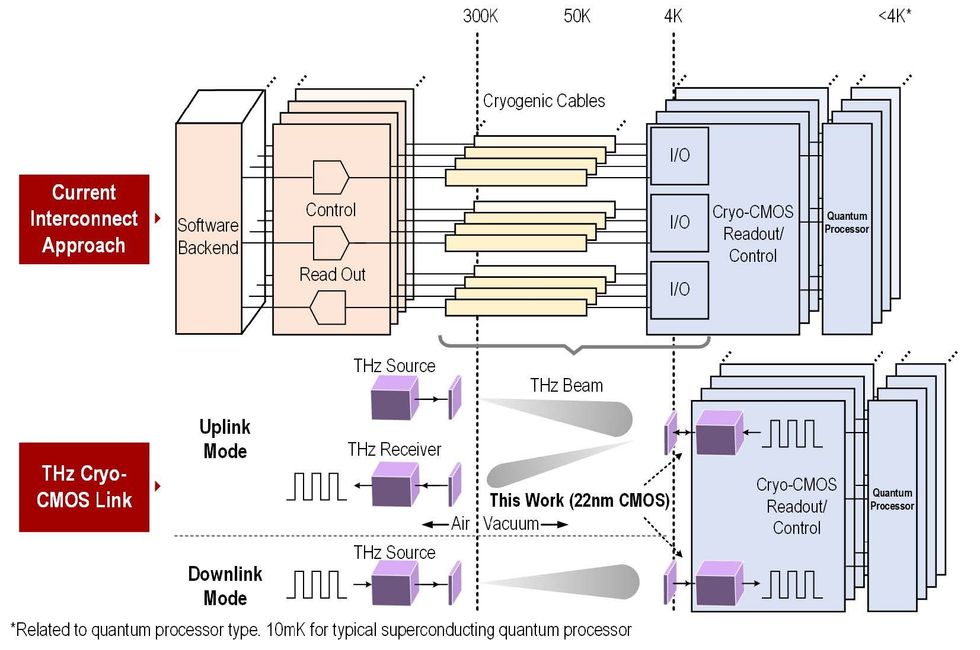Two Oddball Ideas for a Megaqubit Quantum Computer

The perpetual problem with scaling up most quantum computers is a seemingly mundane one-too many cables. Experts say quantum computers might need at least a million qubits kept at near absolute zero to do anything computationally noteworthy. But connecting them all by coaxial cable to control and readout electronics, which work at room temperature, would be impossible.
Computing giants such as IBM, Google, and Intel hope to solve that problem with cyrogenic silicon chips that can operate close to the qubits themselves. But researchers have recently put forward some more exotic solutions that could quicken the pace.
At the IEEE International Electron Device Meeting (IEDM) in December, two groups of researchers suggest that silicon might not be the best answer. Their solutions instead rely on semiconductors and transistors more commonly aimed at near-terahertz-frequency radio. And in February at the IEEE International Solid State Circuits Conference (ISSCC) a separate research group proposed technology that could use terahertz radio to eliminate communication cables altogether.
Shared Quantum WellsA type of device made from compound semiconductors such as indium gallium arsenide rather than silicon and called a high electron-mobility transistor (HEMT) is a natural at amplifying the kind of RF signals needed to interact with qubits. But researchers at Korea Advanced Institute of Technology (KAIST) and at IBM Zurich and Ecole Polytechnique Federale de Lausanne (EPFL) calculate that it could also do the cable-reducing task of routing, multiplexing, and demultiplexing. Crucially, it could do it with little power loss, which is important, because at the coldest parts of the cryogenic chambers used for quantum computers, the refrigerator system can remove only a couple of watts of heat.
HEMTs have a layered semiconductor structure that creates a supernarrow region of free electrons, called a two-dimensional electron gas. Charge moves quickly and with little resistance through this quantum well," hence the HEMT's proficiency at amplifying high-frequency signals. The KAIST and Swiss teams, reasoned that at cryogenic temperatures the 2D electron gas might carry signals with less resistance than metal.
To prove it, they built demultiplexer circuits composed of several transistors and tested them at 5 kelvins. Instead of connecting each transistor to its neighbor with a metal interconnect, they had them share the quantum well. The only metal involved was where the signal entered the multiplexing network and where it exited. No matter how many transistors there are between the input and output there are only two sources of resistance," says SangHeyon Kim, associate professor of electrical engineering at KAIST.
The Switzerland-based team built similar structures, measuring a 32 percent reduction in resistance between two transistors connected by a metal interconnect and two connected by a quantum well. A 1-to-8 multiplexer might need 14 transistors so that resistance improvement adds up quickly.
We're doing quite a lot of things with this technology, some still in planning phase," says Cezar B. Zota, a research staff member at IBM Zurich. His team plans to scale up from their two-transistor test device to a full switching matrix. While Kim's lab is focused on integrating the multiplexers with low-noise amplifiers and other electronics through 3D stacking.
 Qubit control signals could be multiplexed to reduce the number of cables going to the quantum computing chip. Transmitting those signals inside the quantum well [blue] of high electron-mobility transistors generates less heat.IBM Research Zurich
Qubit control signals could be multiplexed to reduce the number of cables going to the quantum computing chip. Transmitting those signals inside the quantum well [blue] of high electron-mobility transistors generates less heat.IBM Research Zurich
Multiplexing can reduce the number of signal cables going to the qubit chip, but what if they could be eliminated altogether? Researchers at MIT, led by associate professor of electrical and computer engineering Ruonan Han, tested a scheme that would use terahertz waves instead. They settled on near-terahertz radiation-specifically 0.26 THz-because, among other reasons, it was too high a frequency to interfere with the qubit operations and worked with small enough antennas.
A full-powered terahertz transceiver would throw off too much heat to place it near the qubit chip. Instead the MIT team designed a terahertz backscatter" system. The system would consist of two transceiver chips, one at the top of the refrigerator, where it's warmest and power consumption is less of an issue, and one at the bottom as part of a 4-kelvin cryogenic control chip linked to the quantum computer chip.
Terahertz radiation is injected into the refrigerator where it's funneled to the top warm transceiver chip. In downlink" mode that transceiver encodes data onto the terahertz radiation. The signals travel down the refrigerator to the bottom where they are picked up by an array of patch antennas on the cold transceiver.
 Instead of using cables to connect external electronics to quantum computers, MIT researchers propose using terahertz radiation.MIT
Instead of using cables to connect external electronics to quantum computers, MIT researchers propose using terahertz radiation.MIT
To get data from the quantum computing chip, the system switches to uplink mode. The warm transceiver sends a steady beam of terahertz radiation down to the cold transceiver. Switches on that chip alter the antenna circuits, causing them to reflect radiation instead of absorbing it, thereby sending data up to the warm transceiver.
In tests of the system, the uplink could send 4 gigabits per second while adding just 176 femtojoules per bit of heat. The downlink was even more energy efficient, at just 34 femtojoules per bit.